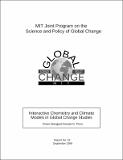| dc.contributor | Wang, Chien. | en_US |
| dc.contributor | Prinn, Ronald G. | en_US |
| dc.date.accessioned | 2003-10-24T14:56:39Z | |
| dc.date.available | 2003-10-24T14:56:39Z | |
| dc.date.issued | 1999-09 | en_US |
| dc.identifier.other | no. 52 | en_US |
| dc.identifier.uri | http://mit.edu/globalchange/www/abstracts.html#a52 | en_US |
| dc.identifier.uri | http://hdl.handle.net/1721.1/3594 | |
| dc.description | Includes bibliographical references (p. 12-16). | en_US |
| dc.description | Abstract in HTML and technical report in PDF available on the Massachusetts Institute of Technology Joint Program on the Science and Policy of Global Change website (http://mit.edu/globalchange/www/) | en_US |
| dc.description.abstract | Continually increasing atmospheric concentrations of radiatively important chemical species such as CO2, CH4, N2O, tropospheric O3, and certain halocarbons most likely will cause future climate changes, which could in turn impact chemical reaction rates and thus lifetimes of many important chemical species. Complicated interactions between climate dynamics and atmospheric chemistry strongly suggest that a fully interactive, comprehensive chemistry-climate modeling system is needed to study the issue. This article reviews recent work in the new and challenging field of interactive chemistry-climate modeling, describing major efforts in model development and summarizing in detail applications of and results from these models. | en_US |
| dc.format.extent | 16 p. | en_US |
| dc.format.extent | 170107 bytes | |
| dc.format.mimetype | application/pdf | |
| dc.language.iso | eng | en_US |
| dc.publisher | MIT Joint Program on the Science and Policy of Global Change | en_US |
| dc.relation.ispartofseries | Report no. 52 | en_US |
| dc.subject.lcc | QC981.8.C5 M58 no.52 | en_US |
| dc.title | Interactive chemistry and climate models in global change studies | en_US |
